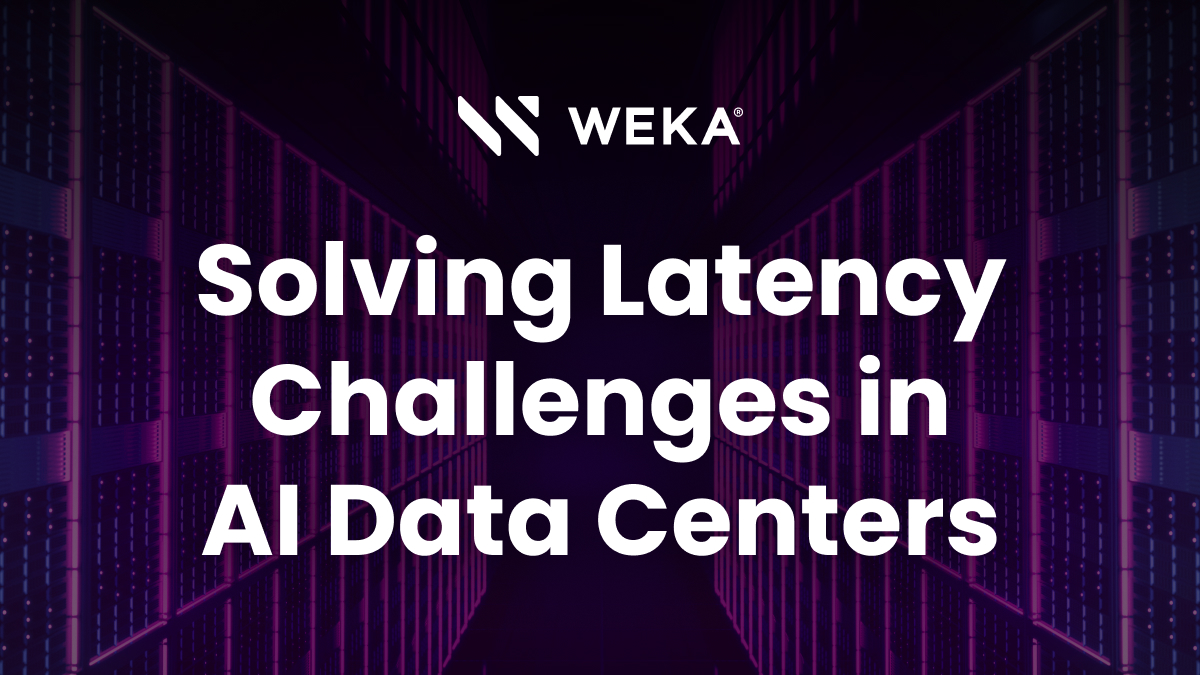The Magic of WEKA Happens at Scale

When people talk about “scale” in infrastructure, they usually think about cost—how expensive it gets when you grow. But the real story of scale is deeper. At small scale, infrastructure feels manageable. Things behave as expected. Systems are stable. But as you grow, chaos creeps in—and then has the potential to explode.
More data, more requests, more users, more hardware… what was once a clean, predictable system starts to bend under pressure. Traditional architectures begin to fragment—fragile under the weight of their own complexity. They become harder to tune, easier to break, and slower to fix. In short, they become fragile in the face of chaos.
Scale Isn’t Just About Cost
It’s easy to assume that scaling up is just a matter of throwing more hardware at a problem. But in reality, scale exposes inefficiencies. Adding more users, more data, and more nodes doesn’t linearly increase the load; it multiplies it in unpredictable ways.
Data at Scale
At small scales, storing and retrieving data is straightforward. But as data grows, new challenges emerge:
- The number of requests skyrockets.
- Small files become a nightmare—traditional file systems choke on them because of high metadata overhead.
- Each file has a tax—overhead per file adds up fast as you scale.
And this isn’t just a problem when small files dominate. Even when they’re only a small percentage of your total workload, they can cause outsized disruption. Why? Because at scale, what used to happen “every once in a while” now happens constantly. Those edge-case issues you could once ignore? Now they’re front and center—and breaking things.
So the question becomes: what do you need when scaling? Is it just raw capacity? Or is it metadata performance, parallel access, rebuild speed, and resilience? Scaling means you must contend with the long tail. That includes the tail latency events that can quietly wreck performance averages and SLA guarantees. If you’re operating infrastructure as a service, your world revolves around three truths:
- You must understand and control unit economics.
- You must reduce tail latency, because it drags down your averages and user experience.
- You must build for failure, because at scale, everything fails all the time—and it rarely fails in correlated, predictable ways.
Traditional systems weren’t built with chaos in mind. WEKA was.
Hardware at Scale: More Than Just “More Boxes”
Scaling data is one thing—scaling infrastructure is another. As you add more hardware to your environment to support more data, complexity starts to compound:
- More nodes mean more moving parts—each one a potential point of failure.
- Switches, transceivers, power supplies—they all multiply, each with their own management complexity and points of failure.
- Cooling and power requirements escalate—your data center isn’t just running hotter, it’s demanding more just to stay alive.
- Inter-node communication becomes critical, and latency-sensitive.
- Failure domains increase with scale—meaning a single misbehaving component can have a wider blast radius.
Traditional storage architectures are not built to abstract this complexity or keep performance consistent as the system scales. Instead of improving, performance and efficiency often degrade. For example, they can’t distribute I/O evenly across thousands of drives—which leads to queue depth problems, hot spots, and unpredictable latency.
WEKA does it differently: by distributing I/O across 1,000 drives across 8+ nodes, WEKA ensures that drives are always operating at peak efficiency, and queue depths stay low. That kind of parallelism isn’t just high performance—it’s stability at scale. Traditional storage just can’t match it.
How to Avoid Fragility at Scale
Scaling isn’t just about adding more—it’s about designing smarter. To avoid fragility at scale, you need to rethink how your infrastructure handles growth, complexity, and failure. Here’s how:
- Distribute and balance everything.
To avoid performance hotspots and failure bottlenecks, design systems where compute, metadata, and data are evenly spread across nodes. - Minimize synchronization dependencies.
The more tightly coupled your systems are, the more fragile they become. Use architectures that reduce the need for constant coordination between components. - Control east-west traffic.
As clusters grow, internal communication can overwhelm the network. Optimize for architectures that limit unnecessary chatter and scale bandwidth intelligently. - Eliminate manual tuning.
Systems that require constant tweaking to stay performant won’t survive scale. Choose platforms that auto-optimize and self-balance. - Design for failure isolation.
Assume everything will fail—just not all at once. Architect with failure domains in mind to contain blast radius and speed recovery. - Reduce tail latency.
Outlier events at scale become the norm. Invest in platforms that minimize tail latency through intelligent I/O scheduling and parallelism.
Scaling is inevitable. Fragility doesn’t have to be.
WEKA: Resilience That Grows With You
Most systems get brittle as they scale—choking on small files, drowning in metadata, and demanding endless tuning just to stay alive. WEKA is different. It doesn’t just withstand the chaos of scale—it thrives on it.
This is what we call WEKA’s antifragile architecture:
- Fully balanced architecture: No single point of contention. WEKA’s approach to data layout means no hotspots—I/O is evenly distributed across the system, delivering consistent performance under pressure.
- WEKA dynamically allocates all resources in real time based on demand: if your cluster needs 100% of CPU for metadata one moment and 100% for data the next, WEKA adapts instantly—no tuning, no bottlenecks, no wasted capacity.
- Performance stays consistent at any capacity—As the cluster fills up, there’s no slowdown in placing data seen in traditional systems as they search for available space.
- Distributed metadata servers: This is a big one. Metadata doesn’t bottleneck because it scales out with your cluster.
- End-to-end data protection ensures what’s written is what’s read—no silent data corruption, no compromise.
- Rebuilds are lightning-fast: WEKA utilizes the entire cluster to rebuild data in parallel, and if the failure was only temporary, it automatically halts the rebuild, conserving compute and avoiding unnecessary work.
- Smart data layout: Data is evenly striped across nodes, improving performance and parallelism.
- Failure domains grow, but risk goes down. While adding nodes increases potential points of failure, WEKA’s massively parallel data striping dramatically reduces the statistical likelihood of data loss, ensuring fast recovery and higher effective availability as you scale.
In WEKA, every node participates in every operation. It’s like a swarm—a single, intelligent system, not a bunch of isolated boxes. No need for tuning, manual rebalancing, or fighting with hot spots.
WEKA was born in the chaos of the cloud—our initial deployments were built in AWS, one of the most failure-prone, noisy environments you can run in. It had to be resilient just to survive. Now imagine delivering peak performance in an environment like that—and then bringing that same resilience to on-prem and hybrid deployments.
One Borg-Like Swarm
WEKA nodes operate as one collective unit, reminiscent of the Borg from sci-fi. But instead of assimilating you, they assimilate the complexity. All that hard stuff—balancing, rebuilding, scaling—gets absorbed and automated. You don’t have to worry about it. You just get speed, resilience, and simplicity, no matter how big you go.
The Bottom Line: Most systems get harder to manage as they grow. WEKA gets better. That’s not just magic. That’s engineering.
See how WEKA’s architecture delivers performance, efficiency, and resilience at scale.
Watch the Webinar





